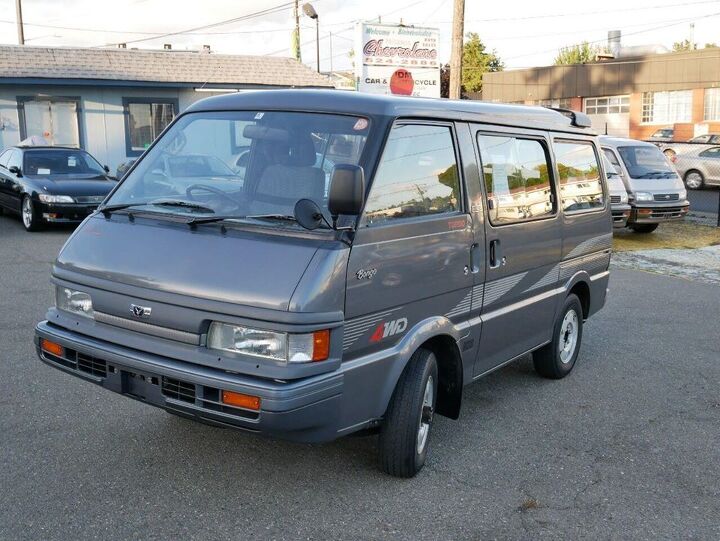Rare Rides: A Mazda Bongo 4×4 - JDM Van Time From 1994

For decades, the Japanese market has loved vans of all shapes and sizes, ranging from basic kei to fully-loaded VIP luxury. Rare Rides has touched on JDM van time just once previously, with a luxurious and capable 1990 Toyota Town Ace. Today we’re taking a look at what Mazda offered a Nineties Japanese consumer of vans.
Mazda’s Bongo offering is a longstanding one, in production since 1966. In 50 years, it’s had just five different generations. Wearing 13 different badges around the globe, at one time or another the Bongo was also branded as a Ford, Kia, Nissan, Mitsubishi, and a Toyota. Not many nameplates have that sort of range. Bongo’s beginnings in the Sixties were rear-engined, sharing engines with the Familia small car lineup. The first generation was short-lived as Mazda went through money trouble, and was cancelled by 1975.
The second-generation offering realized the layout the Bongo would keep for decades: engine in the middle, and rear-wheel drive. The second generation lead a double life: in Japan it stayed as a Mazda, and was produced from 1977 to 1983. But Kia started production of the Bongo in South Korea with the second generation, and played a long game. As Mazda moved on to newer generations of Bongo, Kia stuck with its tried-and-true gen two. Badged as Bongo and Ceres, it remained in production with consistent revisions through 1999.
That brings us to the third-generation Bongo, and the one which was longest lived in Mazda guise. It debuted in 1983 with a new engine lineup. Sales expanded to several different Ford varieties, and Bongo became a Nissan Vanette in the Nineties. Mazda decided not to field its Bongo in the U.S., as other manufacturers were faltering with their offerings. Instead, the company spent some money on a different kind of van that was far ahead of its time: the MPV. Bongo’s third installment lived on through 1999 before being succeeded by a fourth generation that lived through 2018.
Available in its myriad of configurations, the Nineties Bongo was rear-wheel drive or 4×4 and used gasoline and diesel engines. Today’s Rare Ride features the mid-pack 2.0-liter turbodiesel engine; a larger 2.2-liter was available. It sends 76 raucous horsepower through a five-speed manual that includes low-range gearing and four-wheel drive. Luxury options like rear air conditioning were included, though the interior is serious in its spartan nature. With 72,000 miles, it asks $10,995 in Washington.
[Images: seller]

Interested in lots of cars and their various historical contexts. Started writing articles for TTAC in late 2016, when my first posts were QOTDs. From there I started a few new series like Rare Rides, Buy/Drive/Burn, Abandoned History, and most recently Rare Rides Icons. Operating from a home base in Cincinnati, Ohio, a relative auto journalist dead zone. Many of my articles are prompted by something I'll see on social media that sparks my interest and causes me to research. Finding articles and information from the early days of the internet and beyond that covers the little details lost to time: trim packages, color and wheel choices, interior fabrics. Beyond those, I'm fascinated by automotive industry experiments, both failures and successes. Lately I've taken an interest in AI, and generating "what if" type images for car models long dead. Reincarnating a modern Toyota Paseo, Lincoln Mark IX, or Isuzu Trooper through a text prompt is fun. Fun to post them on Twitter too, and watch people overreact. To that end, the social media I use most is Twitter, @CoreyLewis86. I also contribute pieces for Forbes Wheels and Forbes Home.
More by Corey Lewis
Latest Car Reviews
Read moreLatest Product Reviews
Read moreRecent Comments
- ToolGuy This thing here is interesting.For example, I can select "Historical" and "EV stock" and "Cars" and "USA" and see how many BEVs and PHEVs were on U.S. roads from 2010 to 2023."EV stock share" is also interesting. Or perhaps you prefer "EV sales share".If you are in the U.S., whatever you do, do not select "World" in the 'Region' dropdown. It might blow your small insular mind. 😉
- ToolGuy This podcast was pretty interesting. I listened to it this morning, and now I am commenting. Listened to the podcast, now commenting on the podcast. See how this works? LOL.
- VoGhost If you want this to succeed, enlarge the battery and make the vehicle in Spartanburg so you buyers get the $7,500 discount.
- Jeff Look at the the 65 and 66 Pontiacs some of the most beautiful and well made Pontiacs. 66 Olds Toronado and 67 Cadillac Eldorado were beautiful as well. Mercury had some really nice looking cars during the 60s as well. The 69 thru 72 Grand Prix were nice along with the first generation of Monte Carlo 70 thru 72. Midsize GM cars were nice as well.The 69s were still good but the cheapening started in 68. Even the 70s GMs were good but fit and finish took a dive especially the interiors with more plastics and more shared interiors.
- Proud2BUnion I typically recommend that no matter what make or model you purchase used, just assure that is HAS a prior salvage/rebuilt title. Best "Bang for your buck"!







































Comments
Join the conversation
Anything named "Bongo" is cool in my books!
I own the same type of Mazda with petrol engine. It is a nice car to drive. The steering is responsive. The car is quick and has off road power. Mine is Mazda Bongo Wagon 4WD 1994 SSE8R model.I bought it online from Japan in 2012. I would like to buy another one.